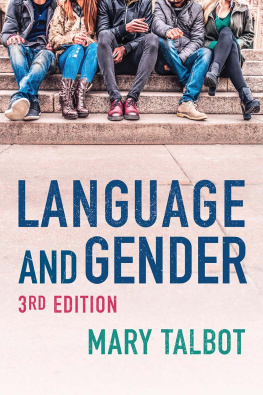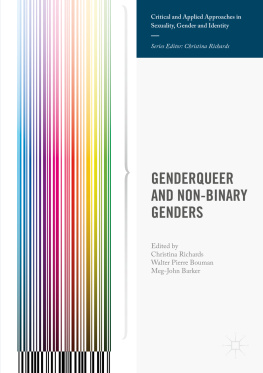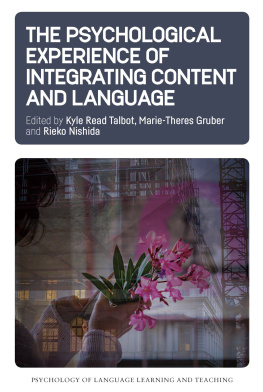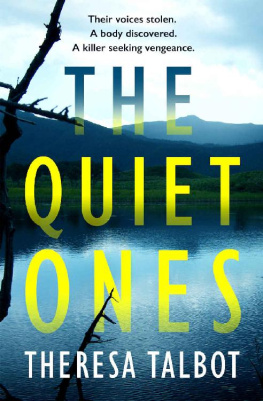
Language and Gender
Third Edition
MARY TALBOT
polity
Copyright Mary Talbot 2020
The right of Mary Talbot to be identified as Author of this Work has been asserted in accordance with the UK Copyright, Designs and Patents Act 1988.
First published in 1998 by Polity Press
This edition published in 2020 by Polity Press
Polity Press
65 Bridge Street
Cambridge CB2 1UR, UK
Polity Press
101 Station Landing
Suite 300
Medford, MA 02155, USA
All rights reserved. Except for the quotation of short passages for the purpose of criticism and review, no part of this publication may be reproduced, stored in a retrieval system or transmitted, in any form or by any means, electronic, mechanical, photocopying, recording or otherwise, without the prior permission of the publisher.
ISBN-13: 978-1-5095-3012-0
A catalogue record for this book is available from the British Library.
Library of Congress Cataloging-in-Publication Data
Names: Talbot, Mary M., 1954- author.
Title: Language and gender / Mary Talbot.
Description: Third edition. | Cambridge, UK ; Medford, MA : Polity Press, 2019. | Includes bibliographical references and index.
Identifiers: LCCN 2019006573 (print) | LCCN 2019008204 (ebook) | ISBN 9781509530120 (Epub) | ISBN 9781509530090 (hardback) | ISBN 9781509530106 (paperback)
Subjects: LCSH: Language and languages--Sex differences.
Classification: LCC P120.S48 (ebook) | LCC P120.S48 T35 2019 (print) | DDC 306.4/4--dc23
LC record available at https://lccn.loc.gov/2019006573
The publisher has used its best endeavours to ensure that the URLs for external websites referred to in this book are correct and active at the time of going to press. However, the publisher has no responsibility for the websites and can make no guarantee that a site will remain live or that the content is or will remain appropriate.
Every effort has been made to trace all copyright holders, but if any have been overlooked the publisher will be pleased to include any necessary credits in any subsequent reprint or edition.
For further information on Polity, visit our website: politybooks.com
Twenty years on
Preface to the third edition
Language and Gender first appeared in 1998. The opportunity to produce a third edition has been a challenge, but a very welcome one. The field has continued to be vibrant. In constant development, it has seen significant shifts since the books initial publication twenty years ago. The content and format of the original evolved from teaching in the 1980s and 1990s, and at the time it presented the field at its most up to date. It was certainly the first book of its kind to examine men and masculinities. If I were writing a book such as this from scratch, would I approach it differently? Yes, of course I would. I certainly wouldnt include a chapter on masculinities focusing solely on cis-gender men, for example.
What I have done for this volume is integrate new perspectives and research with established work, which allowed me to maintain the important historical overview. The historical perspective gives necessary background for an understanding of more recent, theoretically challenging developments.
For the second edition I engaged with key new advances in the field, largely by producing two entirely new chapters. One of these examined gender and sexuality, focusing on heternormativity and resistance. For this new edition, I have added to it some attention to transgender in its coverage of LGBTQ issues. The other new chapter for the second edition dealt with public talk, particularly in politics and the workplace. As well as updating the chapters coverage generally for this new edition, I have incorporated attention to the worrying onslaught of online misogyny. Of course, many of the issues that the book addresses merit chapters indeed books on their own, but in this introduction to the field that would be impossible, owing to constraints of space. In an attempt to compensate for this necessarily limited coverage, I indicate sources providing greater detail in the Further Reading sections for each chapter.
Acknowledgements
Thanks to Angela Smith, Michelle Lazar and Lucy Coleman for their help and support. Im also grateful for the useful suggestions of two anonymous reviewers. Thanks, too, to British cartoonist Jo Nesbitt, for her 1979 postcard that inspired the Its a lesbian! cartoon in .
Cartoons by Alwyn Talbot.
The author and publishers wish to thank the following for permission to use copyright material:
Janet Holmes, Hedging your bets and sitting on the fence: Some evidence for hedges as support structures, Te Reo 27: 4762 (1984).
Judith Baxter, Speaking Out (2006) Palgrave Macmillan.
Susan Ehrlich, The discursive reconstruction of sexual consent, Discourse & Society 9(2): 14972 (1998).
Transcription conventions
| (.) | pause of up to half a second |
| (..) | pause of up to one second |
| (2.5) | approximate timing of longer pauses |
| = | latching (immediate follow-on) |
| heh heheh | laughter |
| (h) | laughter in speech |
| hhhhh | exhales |
| .hhh | inhales |
| (( )) | paralinguistic features and other business |
| (xx) (word) | indistinct utterances |
| > < | more rapid than surrounding speech |
| start of simultaneous speech, top |
| start of simultaneous speech, bottom |
| end of simultaneous speech, top (not always marked) |
| end of simultaneous speech, bottom (not always marked) |
| [ ] | indicates simultaneous speech |
| : | vowel lengthening |
PART I
Preliminaries: Airing Stereotypes and Early Models
Language and gender
Gender is an important division in all societies. It is of enormous significance to human beings. Being born male or female has far-reaching consequences for an individual. It affects how we act in the world and how the world treats us. This includes the language we use and the language used about us. I want this book to make you more conscious of the social category of gender, of the divisions made on the basis of it and, not least, of the part language plays in establishing and sustaining these divisions.
About this book
Politically, this books agenda is feminist. Feminism is a form of politics dedicated to bringing about social changes, and ultimately to arresting the reproduction of systematic inequalities between men and women. Feminist interest in language and gender resides in the complex part language plays, alongside other social practices and institutions, in reflecting, creating and sustaining gender divisions in society. It is this role played by language that is the subject of this book. Examining it will involve us in a wide range of issues, from expectations about how women and men ought to speak to restrictions on womens access to public forms of talk, the division of conversational labour among couples, representations of masculinity and femininity in the mass media, and much more besides.
, Preliminaries: Airing Stereotypes and Early Models, looks at some early work on sex differences in language use and at stereotypes about women. Its three chapters provide a grounding in early work in the field and its central, but problematic, distinction between sex and gender.
Next page








